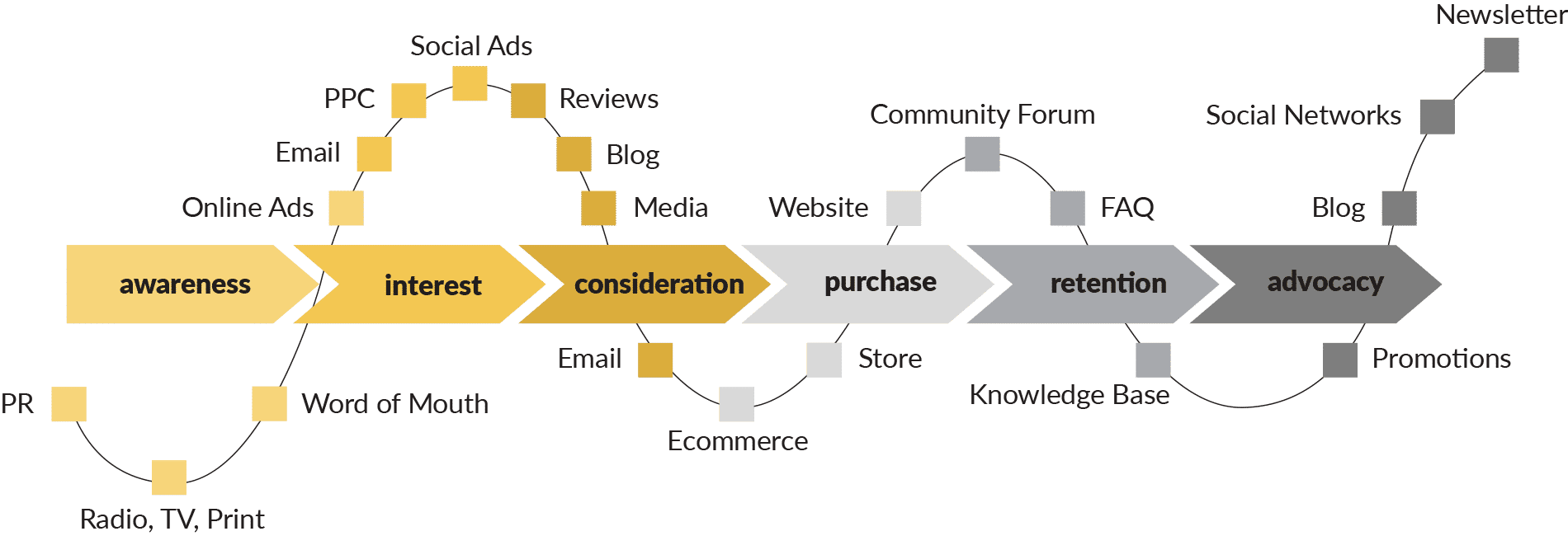Amazon, Google, and Belsimpel are the masters of the customer journey. They have optimized every touchpoint with the consumer. You can learn a lot from these businesses.
In the classical marketing model, marketing is seen as a funnel. At the beginning of the process, there are many companies competing for the attention of the customer, and this number is reduced through the different purchasing stages. According to this outlook, marketing is an action of “pushing” the brand through a few touchpoints such as television ads.
What is the Customer Journey?
In the current digital era, there are many more touchpoints from new types of digital media channels. As a result, the funnel is now seen as a “customer journey”, or rather, a multitude of interconnected journeys. Gartner defines it as “a variety of touchpoints by which the customer moves from awareness to engagement and purchase.”

According to the research company, successful brands focus on developing a seamless experience that ensures each touchpoint interconnects and contributes to the overall journey.
Traditionally, the customer journey is subdivided into 5 steps: awareness, consideration, purchase, retention/service, and loyalty. Later on, in this blogpost, I will dive deeper into these phases.
The Biggest Customer Journey Mistake
Theoretically, the customer journey is not a complex phenomenon. In practice, though, I see many companies making big mistakes applying it. For instance, they give free products to people who are already paying customers. Or, they offer detailed quotations to customers who are only in the awareness phase. In other words, they confuse the different phases of the customer journey, resulting in low conversions.
The trick is to use a matching mode of communication in each step of the customer journey. This will derive the best results. As you will see, psychology plays a big role in mapping the perfect customer journey. The following steps describe the phases in the customer journey, the communication activities that are applicable to these steps, and some great examples from real-life case studies.
- Awareness: Hey, Look at Me!
This is the initial phase of the customer journey. Here customers may have heard about your brand, but they do not act on this knowledge yet: they do not visit your site or make a purchase. In this phase, you will have to trigger your potential customers. Advertising or ‘mass’ communication is the main tool here.
Controversial or funny advertisements are a usefull way to go in the awareness phase. Standing out in the crowd is your goal.
Take for example the Dutch IT company Incentro. In a radio ad, they asked listeners to call their baby “Incentro.” Then you would be eligible for a 5,000 Euro prize. Some thought the advertisement unethical. Others said it was irritating, and there were people who thought the ad was funny. But, people talked about it, and that was just what they wanted.
- Consideration: We are the Kind of Company You Trust
In this phase, customers make a choice. Although they may already have some knowledge about you, they will try to discover more. They also discover the competitor.
At the moment that the consumer makes a choice between different providers, you want to be in the spotlight. Because the customer is now actively searching for information, you need an optimized website (SEO-proof and mobile-friendly) and a nice social media presence.
Now that you have her attention, you want to establish trust, authority and a beginning relationship. This is done in the form of content such as white papers and blog posts. Of course, the copy is optimized for Google and is contentwise tailored to this phase in the customer journey.
This phase is also about building your image. You have to be the kind of business your customer likes and trusts.
Google knows how it works. In professionally produced webinars they explain how their cloud portfolio works and what the advantages are. The company establishes itself as a dependable partner, at the same time giving arguments why to choose Google.
- Purchase: We will make this Process Quick and Easy
At this point, the customer decides to purchase. In this phase, your communication has to be a little more rational than in the Consideration Phase. You give sound reasons why the customer should buy your product, thereby excluding all risk. You give, for example, a warranty.
It is important that the purchase process goes well, quickly, and easily. Furthermore, the customer may need some final arguments to fully convince her.

In this phase, it is important that there is no friction in the process. One of the best examples is Amazon‘s one-click purchasing button. This innovation increased conversion because it shortened the decision-making process considerably. The button made customers happy too; no more hassling with endless check-out procedures.
- Retention/Service: Congratulations, You Bought Our Product!
The customer journey does not stop after the purchase. It is a continuous cycle. Where the previous phases mainly concern usability, it is important in this phase to give the customer a positive experience.
In this phase, you let the customer know he decided wisely by being your customer. One way to accomplish this is through social proof: you tell them that other customers are happy with the product.
Dutch Belsimpel has a simple way to send this message. This reseller of mobile phone subscriptions delivers products such as smartphones in a box that says: “Good choice!”
- Loyalty: You may also Consider…
This phase is all about aftercare. You keep in contact with your customer through, for example, a newsletter, social media, or an app. When you establish a good relationship with your customer through these channels, she will more quickly skip the Consideration Phase.
I also have to mention personalized offers which you can compile on the basis of customer data and an analytics solution. These offers strengthen your bond with the customer, while, at the same time, increasing conversion.
Amazon’s emails are the poster child for this kind of marketing. The e-commerce giant uses data collected from a customer’s shopping history to send offers tailored to their interests. They also send you an email reminding you that you abandoned a shopping cart.

The Customer Journey in Your Organization
There may be not a single business in the world that hasn’t a customer journey to handle. Sadly, some companies fail to see this. These are organizations that don’t understand that every touchpoint with a customer is part of the whole buying experience. Some of these businesses are monopolists; others go out of business.
I know you want to be another kind of business, one that places the customer front and center. At RevelX, we know how to make this wish a reality. If you need our expertise, please make an appointment with one of our experts.
René Jongen
Specialist in top line growth. Supports both corporates that are under a lot of commercial pressure and businesses that are looking for ways to accelerate their growth. Technical physicist. Builds on psychology and neuro-marketing insights.
Related posts
5 Growth Mindset Examples That You Can Use in Your Job Tomorrow
People who believe their success is based on hard work,…
September 15, 2022
Retention strategy: Keeping the right customers
Retaining customers is a top-line priority for any…
May 15, 2020
Who are my most valuable customers?
Legend has it Alfredo Pareto noticed something unusual in…
April 22, 2020



